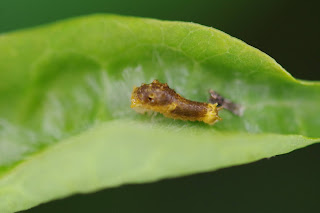Obviously, I went inside to get my camera, and took a few pictures of it, and then I noticed something...
There were moths all around me.
Notice also the beetle at the bottom of the picture.
There were other insects among the milkweed, too, including a few hopper nymphs.
And I found one bee. I don't know if bees sleep, but this one was not active, just holding on where it decided to spend the night. I looked around and didn't see any more bees hanging out for the night, so I don't know why this one was.
I ended up doing a little bit of a nighttime bug walk (more on that later), and found today's Backyard Bug of the Day:
This is not in my bug book. I tried looking it up on the internet, but the only one I found that looked like this, bird-cherry ermine, was on moth site from England, and I don't know if we would have the same species.
Now, back to the milkweed patch, but the daytime version. This is the first insect I photographed today:
Well, technically the first two, since that bumblebee photobombed this shot.
Something is developing inside the monarch egg, but it's hard to tell if it's a monarch caterpillar, or if something has already parasitized it.
I did see a butterfly that could have been a monarch today; it zipped past me as I was standing among the milkweed, but didn't stop to feed or anything else, so I didn't get a clear look at it.
Bee and plume moths
I've already forgotten the name of this skipper from last week...
I couldn't find this one in my book, either. It's similar to a Virigina ctenucha, but much smaller.
One thing I should note about the milkweed is that the last two years, while I had a fair number of milkweed plants, they didn't flower much. Many of the plants last year didn't have flowers on them at all; they never even had buds. This year they are flowering abundantly, and the bees are responding:
Also here, lady beetle and another kind of beetle.
The bees are mostly very active, there's very little resting and basking.
I came across a vine on my bug walk that had, in the space of about 8 inches, a variety of insects:
There were several assassin bug nymphs.
Also much prey (which they ignored), like this plant hopper nymph.
And this one. I think this is a candy striped leaf hopper nymph.
About an inch away was this katydid nymph.
I happened to notice that same vine during my late-night bug walk, too:
Some kind of Hemiptera and another species of hopper nymph
Cockroach
Plant bug
Another katydid nymph, much larger, so later instar
I think these two hopper nymphs were there, in those same spots, in the afternoon.
A leaf-footed bug nymph.
Grasshopper nymph
Possibly adult and larva of the same lady beetle species?
I found this caterpillar in the afternoon:
It appears to be a swallowtail, but the color looks different than I have seen for eastern tiger swallowtail. Swallowtails tend to look very different in early instars than they will later, and my book mostly just shows the later, so I don't know if this is an e.t.s. in a coloring I have not seen before, or if it's a different swallowtail species. Another possibility is that this is just after it molted, and it's color hasn't developed yet. That appears to be its exuvia beside it, and...
... I saw it on my late-night bug walk also; the exuvia was gone (some caterpillars eat the skin they have just shed), and the color looks a little different. Still not what I expect for an eastern tiger swallowtail. I'll try to keep an eye on it, but who knows how long it will stick around in that spot?
For a couple of weeks I was seeing several of these weevils every day, and then suddenly they were gone. Today I saw two.
Cockroach seen on my late-night bug walk
Arachnid Appreciation:
.
.
.
.
.
.
.
.
.
.
.
.
With all of that potential prey on the milkweed, of course there are predators. I saw several spiders last night (most in places I couldn't photograph them), including this one that had caught a moth. Some kind of crab spider.
If you're an insect, the safest time to be near a spider is when it's already feeding on something else.
On the milkweed earlier in the day I found these two spiders:
On a goldenrod leaf




















































No comments:
Post a Comment